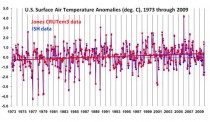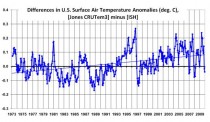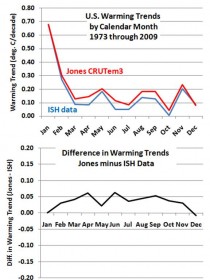By Roy W. Spencer, Ph. D.
As I discussed in my last post, I’m exploring the International Surface Hourly (ISH) weather data archived by NOAA to see how a simple reanalysis of original weather station temperature data compares to the Jones CRUTem3 land-based temperature dataset.
While the Jones temperature analysis relies upon the GHCN network of ‘climate-approved’ stations whose number has been rapidly dwindling in recent years, I’m using original data from stations whose number has been actually growing over time. I use only stations operating over the entire period of record so there are no spurious temperature trends caused by stations coming and going over time. Also, while the Jones dataset is based upon daily maximum and minimum temperatures, I am computing an average of the 4 temperature measurements at the standard synoptic reporting times of 06, 12, 18, and 00 UTC.
U.S. TEMPERATURE TRENDS, 1973-2009
I compute average monthly temperatures in 5 deg. lat/lon grid squares, as Jones does, and then compare the two different versions over a selected geographic area. Here I will show results for the 5 deg. grids covering the United States for the period 1973 through 2009.
The following plot (enlarged here) shows that the monthly U.S. temperature anomalies from the two datasets are very similar (anomalies in both datasets are relative to the 30-year base period from 1973 through 2002). But while the monthly variations are very similar, the warming trend in the Jones dataset is about 20% greater than the warming trend in my ISH data analysis.

This is a little curious since I have made no adjustments for increasing urban heat island (UHI) effects over time, which likely are causing a spurious warming effect, and yet the Jones dataset which IS (I believe) adjusted for UHI effects actually has somewhat greater warming than the ISH data.
A plot of the difference between the two datasets is shown next (enlarged here), which reveals some abrupt transitions. Most noteworthy is what appears to be a rather rapid spurious warming in the Jones dataset between 1988 and 1996, with an abrupt “reset” downward in 1997 and then another spurious warming trend after that.

While it might be a little premature to blame these spurious transitions on the Jones dataset, I use only those stations operating over the entire period of record, which Jones does not do. So, it is difficult to see how these effects could have been caused in my analysis. Also, the number of 5 deg grid squares used in this comparison remained the same throughout the 37 year period of record (23 grids).
The decadal temperature trends by calendar month are shown in the next plot (enlarged here). We see in the top panel that the greatest warming since 1973 has been in the months of January and February in both datasets. But the bottom panel suggests that the stronger warming in the Jones dataset seems to be a warm season, not winter, phenomenon.

Of particular interest to me at this point is a simple and objective method for quantifying and removing the spurious warming arising from the urban heat island (UHI) effect. The recent paper by McKitrick and Michaels suggests that a substantial UHI influence continues to infect the GISS and CRU temperature datasets.
In fact, the results for the U.S. I have presented above almost seem to suggest that the Jones CRUTem3 dataset has a UHI adjustment that is in the wrong direction. Coincidentally, this is also the conclusion of a recent post on Anthony Watts’ blog, discussing a new paper published by SPPI.
It is increasingly apparent that we do not even know how much the world has warmed in recent decades, let alone the reason(s) why. It seems to me we are back to square one. See post and much more here.
By Geoffrey Lean, in Bali, The Telegraph
Environment and Climate ministers meeting in closed session in Bali last night insisted that an independent review should be carried out following the publicising of mistakes in its last report, and a row surrounding Dr Pachauri’s robust response to his critics. If his management is found to be at fault his position could become untenable.

Participants in the unprecedented meeting - held at the annual assembly of the Governing Council of the United Nations Environment Programme’s (UNEP) Governing Council in Bali - were sworn to secrecy over the decision and it is only expected to be announced after its detaled scope and composition have been worked out by UNEP and the World Meteorological Organisation, the two UN agencies that oversee the IPCC’s work.
The ministers - led by Hillary Benn, the Environment Secretary,and his counterparts from Germany,. Norway, Algeria and Antigua and Barbuda - refused to allow Dr Pachauri to decide who would carry out the review, insisting it must be completely and demonstrably independent of the IPCC.
The two agencies are expected first to approach national academies of sciences and to ensure that it examines the management of the organisation as well as its scientific procedures.
The review is to report by August to allow time for its conclusions - and Dr Pachauri’s position - to be assessed before the IPCC meets for its own annual assembly in Korea in October.
Achim Steiner, UNEP’s Executive Director said that the IPCC faced a “crisis of confidence” with the public. , According to participants at the meeting, Dr Pachauri expressed regret for any mistakes that had been made, but stopped short of apologising for them. “He gave the impression of making an apology without actually doing so”, said one.
The participants add that he admitted only one mistake, a discredited prediction that the glaciers of the Himalayas would entirely melt away by 2035, for which the IPCC has already apologised. They say he described other alleged errors - such as a prediction that food production in parts of Africa might be cut in half by 2020 or the citing of studies by pressure groups rather than peer-reviewed research - as misunderstandings.
The ministers regard the mistakes as exaggerated, point out that they just concern a few sentences in a 3000 page report, and say they do not in any way undermine the basic science behind global warming. Their main concern has been over the aggressive way in which Dr Pachauri has responded to criticism, beginning with denouncing Indian research suggesting that the glaciers were not melting so rapidly as “voodoo science”.
Many wish he would resign,. But he was reelected unopposed less than 18 months ago,and has often rejected doing so. He refused to comment on the latest developments.
Read more here.
---------------------------
Punitive taxes would cost jobs, hitting economy
By Senator James Inhofe in the Hill
The surest way to rejuvenate our ailing economy, create American jobs, and strengthen our energy security is through an “all-of-the-above” energy policy that encourages production of our vast domestic resources. We can and should utilize all of the energy available to us, including natural gas, oil, coal, and nuclear - along with emerging alternative energy sources like wind, biofuels, geothermal, and solar. A new non-partisan government report shows that America is an energy-rich nation. The Congressional Research Service found that America’s combined supply of recoverable natural gas, oil, and coal is the largest on Earth. In fact, the CRS reports that America’s recoverable resources are far larger than those of Saudi Arabia (3rd), China (4th), and Canada (6th) combined - and that’s without including America’s immense oil shale and methane hydrates deposits. Additionally, just-released Department of Energy statistics show that the United States has eclipsed Russia as the world’s largest producer of natural gas.
To the detriment our energy security and the economy, the Obama administration - through, in some cases, explicit regulations and purposeful inaction - is keeping much of our abundant energy supply off-limits. As with most of my colleagues, I appreciated President Barack Obama’s support for nuclear energy and natural gas during his State of the Union address last month. But the release of the Obama budget just one week later told a much different story, especially when it comes to natural gas.
The Obama administration’s 2011 budget - once again - proposes a crippling tax increase on America’s homegrown natural gas and oil industry - specifically, $36.5 billion of new taxes, which would be paid by consumers in the form of higher heating bills and higher prices at the gas pump. (It’s worth noting the stubbornness of this administration: This tax comes after Congress rejected Obama’s $31 billion energy tax increase in last year’s budget.)
In his State of the Union address, President Obama pledged to put America back to work. The domestic oil and gas industry is a great place to start. Last September, PricewaterhouseCoopers released a report finding that “the U.S. oil and natural gas industry’s total employment contribution to the national economy amounted to 9.2 million full-time and part-time jobs, accounting for 5.2 percent of the total employment in the country ... The industry’s total value-added contribution to the national economy was over $1 trillion, accounting for 7.5 percent of U.S. GDP in 2007.”
But the benefits of affordable, abundant, and domestic energy production don’t stop there: hundreds of thousands of land and mineral owners - some of whom are farmers and ranchers - from 33 producing states receive monthly checks from natural gas and oil royalties produced on their properties. And states receive tens of billions of dollars in natural gas and oil excise and severance taxes that support roads, schools, and law enforcement. Yet by punishing America’s oil and natural gas industry with new taxes, President Obama is impoverishing states, harming consumers, and stifling creation of new jobs.
Those who ignore history are condemned to repeat it: that’s one of the unfortunate lessons of the Obama energy tax. Just turn back the clock to 1980. Then-President Jimmy Carter imposed a similar tax on the oil and gas industry, ostensibly to increase our energy independence and lower prices at the pump. It didn’t work. A government report from CRS later found the following: “The WPT [windfall profits tax] reduced domestic oil production between 3 and 6 percent, and increased oil imports from between 8 and 16 percent ... This made the U.S. more dependent upon imported oil.”
Punitive energy taxes didn’t work in 1980, and they won’t work now.
President Obama appears to suffer from an energy cataract. So-called “green energy” is all he can see - while all other forms of energy are punished or ignored. And what has American gained? The Los Angeles Times noted recently that “[President] Obama promised to create some 5 million green jobs over a decade. The stimulus bill approved last year allocated billions of dollars to the clean energy sector ... Last month, government economists released their first tally of clean energy jobs created or saved by the stimulus: 52,000.”
These results are simply tragic, given that millions of new jobs can be created through a few simple policy reforms - reforms that will, among many other benefits, make energy more affordable and reliable. President Obama has stressed the need for bipartisanship to jumpstart America’s economy. I agree, and the solution is ready at hand: it’s called American energy, in all its forms.
Read more here.
See interview with the Hill here:
By Bob Ferguson, SPPI Blog
In Senate EPA hearings today false claims were made by Senators Boxer (D-CA) and Merkley (D-OR) that the Science and Public Policy Institute (SPPI) is Exxon Mobil funded, implying its work and findings should be cast aside.
Says SPPI president, Robert Ferguson, “SPPI has never been offered or accepted funds or support in any form from Exxon Mobil. Senators Boxer and Merkley owe an apology and a correction in the record.” Added Ferguson, “It is rather simple for any senate staffer to call Exxon Mobil to verify the facts, or examine public filings for Exxon Mobil’s Contributions and Community Investments.”
The intended slurs came as EPA Administrator Lisa Jackson faced stern questioning from Senator James Inhofe (R-AR) and Senator John Barrasso (R-WY) about recent revelations of the shoddiness of the science underpinning the EPA’s CO2 ‘endangerment’ finding.
Senator Barrasso referenced a recent study by SPPI indicating that NASA and NOAA temperature records had been manipulated, and asked the Administrator if she’d be willing to have the EPA IG investigate and review the allegations.
In Surface Temperature Records - Policy-driven Deception?, veteran meteorologists Joe D’Aleo and Anthony Watts analyzed world temperature records with the startling conclusion that instrumental land temperature data for the pre-satellite era (1850-1980) have been so widely and systematically tampered with that it cannot be safely said that there has been any significant global warming in the 20th century. In the oceans, data are missing and uncertainties are substantial. Comprehensive coverage has only been available since 2003, and shows no warming.
On the other hand, the Senators have not objected that in 2002, Exxon Mobil donated $100-million - $10-million a year for 10 years running - to Stanford University “for research into global warming and renewable energy alternatives.” Neither did the Senators suggest rejection of “oiled” testimony from any witness from Stanford University, including extreme alarmist Stephen Schneider’s in 2003.
Do Senators Boxer and Merkley dismiss as tainted any testimony or research produced from the University of California, Berkeley faculty or employees in light of its $500-million alliance with foreign oil giant British Petroleum?
Other academic institutions supported by Exxon Mobil include Columbia, George Washington, Georgetown, Johns Hopkins, Northwestern, North Carolina, Texas and the Harvard Smithsonian (a “corporate partner").
Also, MIT’s hurricane researcher, Kerry Emanuel, has accepted reimbursement payments from Exxon Mobile funded Frontiers of Freedom Institute for participating with NOAA’s Chris Landsea in a congressional staff briefing. Would Dr. Emanuel’s testimony be considered tainted by Senators Boxer and Merkley?
The funding sources the Senators should be most dismissive of are those from governments. Another SPPI study, Climate Money, revealed that the US federal government has a near monopsony on climate research funding. Where a monopoly market consists of a single seller, a monopsony market consists of a single buyer. The only thing the government buys is policy-driven data and manufactured alarmism, and it has done so to the tally of more than $79 billion of taxpayers’ money since 1989 - and counting. By comparison, Exxon Mobil’s grants to “skeptics” of climate apocalypse is less that a thousandth of what the US government spends on alarmists, and less than one five-thousandth of the value of carbon trading in 2008 alone.
Concluded Ferguson, “The act of dismissing information and data from SPPI which is not Exxon funded and accepting them from sources who are Exxon funded - all the while saying Exxon funding disqualifies testimony - is Theater of the Absurd. If the senators and their staffs truly seek a better understanding of the current state of climate science, they should read more Lindzen and less Alinsky.”
Perhaps California and Oregon voters will see it that way, too. See SPPI blog here.
See also the SPPI blog Post on the Washington Post story How Al Gore Wrecked Planet Earth here.


